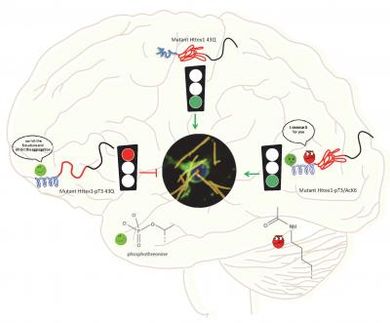Artificial intelligence makes enzyme engineering easy
Researchers have streamlined the traditionally slow process of enzyme engineering
You can't expect a pharmaceutical scientist to switch labs to the facilities available in a television studio and expect the same research output. enzymes behave exactly the same. But now, in a study recently published in ACS Synthetic Biology, researchers from Osaka University have imparted an analogous level of adaptability to enzymes, a goal that has remained elusive for over 30 years.

Symbolic image
Computer-generated image
Enzymes perform impressive functions, enabled by the unique arrangement of their constituent amino acids, but usually only within a specific cellular environment. When you change the cellular environment, the enzyme rarely functions well—if at all. Thus, a long-standing research goal has been to retain or even improve upon the function of enzymes in different environments; for example, conditions that are favorable for biofuel production. Traditionally, such work has involved extensive experimental trial-and-error that might have little assurance of achieving an optimal result.
Artificial intelligence can minimize this trial-and-error, but still relies on experimentally obtained crystal structures of enzymes—which can be unavailable or not especially useful. Thus, "the pertinent amino acids one should mutate in the enzyme might be only best-guesses," says Teppei Niide, co-senior author. "To solve this problem, we devised a methodology of ranking amino acids that depends only on the widely available amino acid sequence of analogous enzymes from other living species."
The researchers focused on the amino acids that are involved in the specificity of the malic enzyme to the molecule that the enzyme transforms (i.e., the substrate) and to the substance that helps the transformation proceed (i.e., the cofactor). By identifying the amino acid sequences that did not change over the course of evolution, the researchers identified the amino acid mutations that are adaptations to different cellular conditions in different species.
"By using artificial intelligence, we identified unexpected amino acid residues in malic enzyme that correspond to the enzyme's use of different redox cofactors," says Hiroshi Shimizu, co-senior author. "This helped us understand the substrate specificity mechanism of the enzyme and will facilitate optimal engineering of the enzyme in laboratories."
This work succeeded in using artificial intelligence to dramatically accelerate and improve the success of substantially reconfiguring an enzyme's specific mode of action, without fundamentally altering the enzyme's function. Future advances in enzyme engineering will greatly benefit fields such as pharmaceutical and biofuel production that require carefully tuning the versatility of enzymes to different biochemical environments—even in the absence of corresponding enzymes’ crystal structures.
Original publication
Other news from the department science

Get the analytics and lab tech industry in your inbox
By submitting this form you agree that LUMITOS AG will send you the newsletter(s) selected above by email. Your data will not be passed on to third parties. Your data will be stored and processed in accordance with our data protection regulations. LUMITOS may contact you by email for the purpose of advertising or market and opinion surveys. You can revoke your consent at any time without giving reasons to LUMITOS AG, Ernst-Augustin-Str. 2, 12489 Berlin, Germany or by e-mail at revoke@lumitos.com with effect for the future. In addition, each email contains a link to unsubscribe from the corresponding newsletter.























































